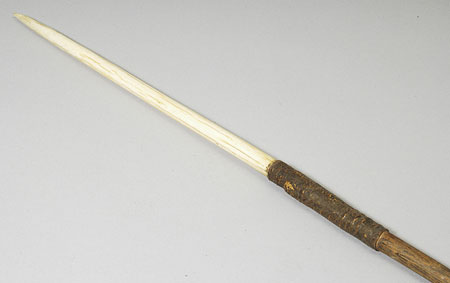Accession Number:
1936.10.4
Country:
Sudan
Region:
[Southern Sudan]
Cultural Group:
Anywaa [Anuak]
Date Made:
By 1936
Materials:
Animal Bone , Wood Plant , Animal Hide Skin , Animal Hair , Animal Tail
Process:
Carved , Polished , Socketed , Decorated
Dimensions:
Total L = 1926; spear-head L = 341 (to top of sheath), diam = 16.7 x 16.1; sheath L = 115, diam = 21.3 x 19; shaft diam = 16.7 x 16, hair tassels L = 170 and 210 [RTS 12/7/2005].
Weight:
342.8 g
Other Owners:
Presumably collected by Evans-Pritchard during his period of fieldwork amongst the Anuak between early March and May 1935 [RTS 18/6/2004].
Field Collector:
Edward Evan Evans-Pritchard
PRM Source:
Edward Evan Evans-Pritchard
Acquired:
Donated 1936
Collected Date:
March - May 1935
Description:
Spear consisting of a spearhead with pointed tip, tapering out to a narrow body with oval section, carved from a light cream coloured giraffe's leg bone (Pantone 7499C).
The base of this rests against, or is hafted into, a long narrow shaft of orangey brown wood (Pantone 7510C), also with an oval section, that in turn tapers to a flat butt.
Both parts have been polished.
The junction between them is covered with a cylindrical sheath cut from a section of yellowish brown animal's tail with the hair removed (Pantone 7509C); this was stretched over the body whilst wet and then shrunken in place, with the surface lightly tooled to give it a textured appearance, made up of lentoid-shaped impressions.
The lower part of the shaft has also been decorated with cut sections of animal tail, consisting of hide rings with long black hair still attached to the outside face, to create a series of tassels, with the hair extending upwards along the shaft body (Pantone Black 7C).
There is a small group of 2 such tassels, a gap, then a further group of 2 just above the butt.
Immediately above this second group are 3 skin rings, cut from a lighter coloured tail section (Pantone 7509C), but lacking all but a few strands of their associated buff coloured hair, suggesting the tassels in this part were originally thicker and made up of more than one colour.
The spear is complete in itself, apart from these tassels which are worn and not as thick as they once had been.
The spear has a weight of 342.8 grams and is 1926 mm long with a shaft diameter of 16.7 by 16 mm.
The point measures 341 mm from its tip to the top of the sheath, and has a maximum diameter of 16.7 by 16.1 mm, while the sheath itself is 115 mm long and has a maximum diameter of 21.3 by 19 mm.
The hair tassels are 170 and 210 mm long respectively.
This spear was collected in the Sudan by Edward Evan Evans-Pritchard, presumably between early March and May 1935 when he conducted fieldwork amongst the Anuak (E.E. Evans-Pritchard, 1940, The Political System of the Anuak of the Anglo-Egyptian Sudan, p. 3).
For other spears in the collection tipped with giraffe bone points, see 1936.10.5 (Anuak, collected by Evans-Pritchard), 1925.67.2 and 1919.13.19-20 (Possibly Dinka, purchased at the Stevens Auction Rooms). Evans-Pritchard also states that the Nuer occasionally made use of giraffe bone for spears: 'Till recently they possessed very few iron spears, cherished as heirlooms, but used instead the straightened horns of antelope and buck, ebony wood, and the rib-bones of giraffe, all of which are still used to-day, though almost entirely in dances ...’ (E.E. Evans-Pritchard, 1940, The Nuer, p. 86).
Rachael Sparks 5/8/2005.
This spear was collected in the Sudan by Edward Evan Evans-Pritchard, presumably between early March and May 1935 when he conducted fieldwork amongst the Anuak (E.E. Evans-Pritchard, 1940, The Political System of the Anuak of the Anglo-Egyptian Sudan, p. 3).
For other spears in the collection tipped with giraffe bone points, see 1936.10.5 (Anuak, collected by Evans-Pritchard), 1925.67.2 and 1919.13.19-20 (Possibly Dinka, purchased at the Stevens Auction Rooms). Evans-Pritchard also states that the Nuer occasionally made use of giraffe bone for spears: 'Till recently they possessed very few iron spears, cherished as heirlooms, but used instead the straightened horns of antelope and buck, ebony wood, and the rib-bones of giraffe, all of which are still used to-day, though almost entirely in dances ...’ (E.E. Evans-Pritchard, 1940, The Nuer, p. 86).
Rachael Sparks 5/8/2005.
Primary Documentation:
Accession Book Entry
[p.
410] - 1936 [insert] 10 [end insert] E.
EVANS-PRITCHARD, M.A., Exeter College, Oxford.
- Specimens collected by himself in the EASTERN SUDAN, while travelling with a Grant from the
Rockefeller
Leverhulme Trustees, viz: [insert] 4-5 [end insert] - [One of] 2 Spears with long points of giraffe’s leg-bone, ANUAK, NUER-ANUAK border.
Card Catalogue Entry - There is no further information on the catalogue card [RTS 30/1/2004].
Pitt Rivers Museum label - AFRICA, Sudan. Anuak tribe. Spear with giraffe bone point. d.d. E.E. Evans-Pritchard 1936 [plastic coated label, tied to object; RTS 12/7/2005].
Written on object - Spear, tipped with giraffe's bone. ANUAK tribe. NUER-ANUAK BORDER, E. SUDAN. d.d. E. Evans-Pritchard, 1936 [RTS 12/7/2005].
Card Catalogue Entry - There is no further information on the catalogue card [RTS 30/1/2004].
Pitt Rivers Museum label - AFRICA, Sudan. Anuak tribe. Spear with giraffe bone point. d.d. E.E. Evans-Pritchard 1936 [plastic coated label, tied to object; RTS 12/7/2005].
Written on object - Spear, tipped with giraffe's bone. ANUAK tribe. NUER-ANUAK BORDER, E. SUDAN. d.d. E. Evans-Pritchard, 1936 [RTS 12/7/2005].




